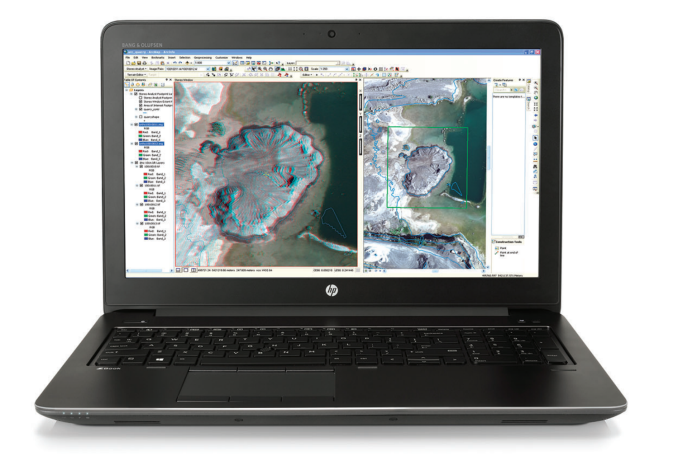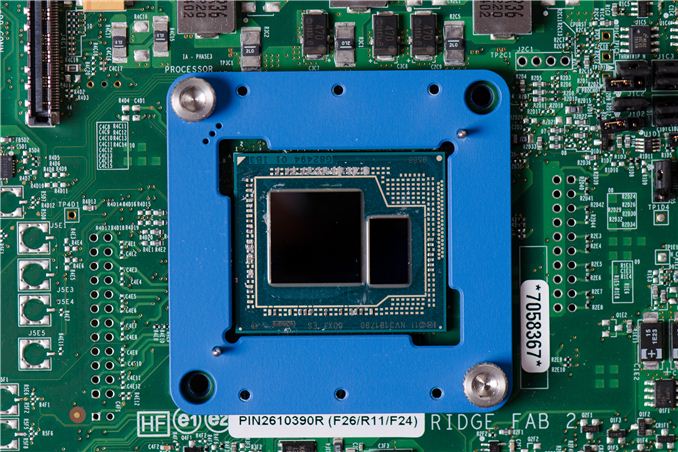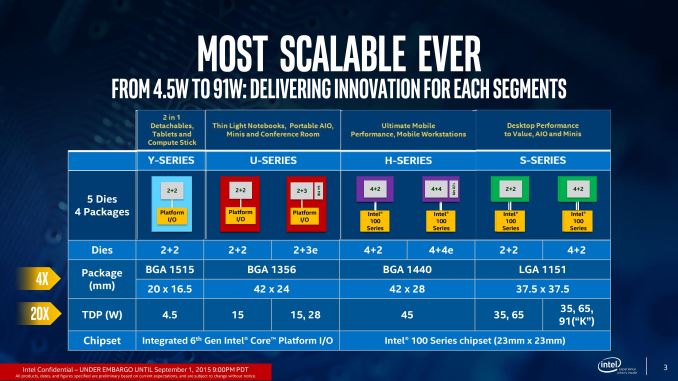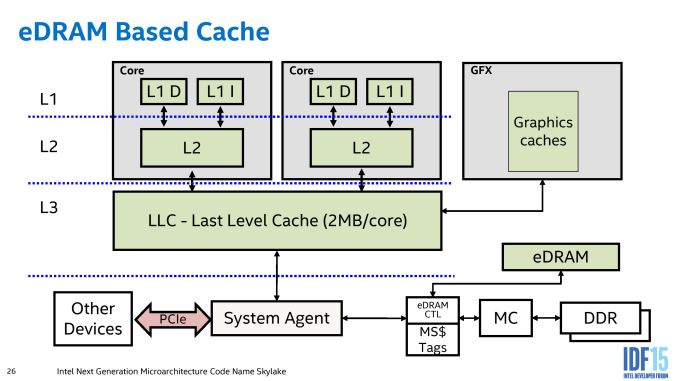Skylake Iris Pro hits Intel’s Pricing Lists: Xeon E3-1575M v5 with GT4e
by Ian Cutress on January 26, 2016 12:17 PM EST- Posted in
- CPUs
- Intel
- Mobile Workstation
- Xeon
- Mobile
- Laptops
- Enterprise
- Skylake
- eDRAM

One of our forum members, Sweepr, posted Intel’s latest pricing list for OEMs dated the 24th of January and it contained a number of interesting parts worth documenting. The Braswell parts and Skylake Celerons were disclosed over the past few months are now available to OEMs, but it’s the parts with Iris Pro that have our attention.
Iris Pro is Intel’s name for their high end graphics solution. Using their latest graphics microarchitecture, Gen9, Iris Pro packs in the most execution units (72) as well as a big scoop of eDRAM. At the minute we assume it’s the 128 MB edition as Intel’s roadmaps have stated a 4+4e part only on mobile, rather than a 4+3e part with 64 MB (only the 2+3e parts are listed as 64MB), although we are looking for confirmation.
The new parts are listed as:
Xeon E3-1575M v5 (8M cache, 4 Cores, 8 Threads, 3.00 GHz, 14nm) - $1,207
Xeon E3-1545M v5 (8M cache, 4 Cores, 8 Threads, 2.90 GHz, 14nm) - $679
Xeon E3-1515M v5 (8M cache, 4 Cores, 8 Threads, 2.80 GHz, 14nm) - $489
These will compare to the non-Iris Pro counterparts, running P530 graphics (4+2, 24 EUs):
Xeon E3-1535M v5 (8M cache, 4 Cores, 8 Threads, 2.90 GHz, 14nm) - $623
Xeon E3-1505M v5 (8M cache, 4 Cores, 8 Threads, 2.80 GHz, 14nm) - $434
As Sweepr points out, the difference between the 2.8-2.9 GHz parts is only $55-56. That is for both the increase in graphics EUs (24 to 72) as well as that extra on-package eDRAM.

The i7-4950HQ with 128 MB eDRAM
We have more reasons to be excited over the eDRAM in Skylake than what we saw before in Haswell with the i7-4950HQ on mobile and Broadwell on desktop with the i7-5775C, i5-5765C and the relevant Xeons. With the older platforms, the eDRAM was not a proper bidirectional cache per se. It was used as a victim cache, such that data that was spurned from the L3 cache on the CPU ended up in eDRAM, but the CPU could not place data from the DRAM into the eDRAM without using it first (prefetch prediction). This also meant that the eDRAM was invisible to any other devices on the system, and without specific hooks couldn’t be used by most software or peripherals.
With Skylake, this changes, the eDRAM lies beyond the L3 and the System Agent as a pathway to DRAM, meaning that any data that wants DRAM space will go through the eDRAM in search for it. Rather than acting as a pseudo-L4 cache, the eDRAM becomes a DRAM buffer and automatically transparent to any software (CPU or IGP) that requires DRAM access. As a result, other hardware that communicates through the system agent (such as PCIe devices or data from the chipset) and requires information in DRAM does not need to navigate through the L3 cache on the processor. Technically graphics workloads still need to circle around the system agent, perhaps drawing a little more power, but GPU drivers need not worry about the size of the eDRAM when it becomes buffer-esque and is accessed before the memory controller is adjusted into a higher power read request. The underlying message is that the eDRAM is now observed by all DRAM accesses, allowing it to be fully coherent and no need for it to be flushed to maintain that coherence. Also, for display engine tasks, it can bypass the L3 when required in a standard DRAM access scenario. While the purpose of the eDRAM is to be as seamless as possible, Intel is allowing some level on control at the driver level allowing textures larger than the L3 to reside only in eDRAM in order to prevent overwriting the data contained in the L3 and having to recache it for other workloads.
We go into more detail on the changes to Skylake’s eDRAM in our microarchitecture analysis piece, back from September.
The fact that Intel is approaching the mobile Xeon market first, rather than the consumer market as in Haswell, should be noted. eDRAM has always been seen as a power play for heavy DRAM workloads, which arguably occur more in professional environments. That still doesn’t stop desktop users requesting it as well – the fact that the jump from 4+2 to a 4+4e package is only $55-$56 means that if we apply the same metrics to desktop processors, an i5-6600K with eDRAM would be $299 in retail (vs. $243 MSRP on the standard i5-6600K).
One of the big tasks this year will be to see how the eDRAM, in the new guise as a DRAM buffer, makes a difference to consumer and enterprise workloads. Now that there are two pairs of CPUs on Intel’s pricing list that are identical aside from the eDRAM, we have to go searching for a source. It seems that HP has already released a datasheet showing the HP ZBook 17 G3 Mobile Workstation as being offered with the E3-1575 v5, which Intel lists as a whopping $1207. That's certainly not the extra $55.
Source: AnandTech Forums, Intel












72 Comments
View All Comments
Gothmoth - Tuesday, January 26, 2016 - link
it´s all so boring..... i wait for 8 or 12 core desktop systems that can be overlocked and don´t run at 140watt.beside my day job i am a freelance 3d artist and i need all the computing power i can get.
my 5280k gest a bit long in the thooth.. well it coudl be faster from the start.
yet intels makes baby steps when it comes to computing power.
for me they could get rid of the GPU part and spend that die size to give me a faster CPU.
darckhart - Tuesday, January 26, 2016 - link
I hear that. I have a 6-core on X58 and ... nope nothing interesting for me yet. any new 6-core is on a dying socket, or half-step behind. no sense in "upgrading" to a 4-core with "a much better but still sucky compared to discrete graphics" part. and now that intel wants to lock xeon to server chipsets.... meh.Ammaross - Tuesday, January 26, 2016 - link
Ditto here. My next upgrade will be a 6 or 8-core. These 4-core i7 chips (even OCed to 4.4Ghz) sit at 100% way too much for my needs.willis936 - Tuesday, January 26, 2016 - link
You're asking for the impossible. I'm fine with the power bill of a single machine if it gives me king of the hill single threaded performance, 4 very fast memory channels, lots of PCIe lanes to play with, and lots of cores for multithreaded applications. I have a 48 thread system but it struggles to host a modded MC server because 2.7 GHz IVB doesn't cut it for single threaded performance.ImSpartacus - Tuesday, January 26, 2016 - link
Impossible? Idk, wasn't cannonlake-s rumored to bring 8 cores to the 95W lineup? 10nm seems like a good time for a gun-shy Intel to finally bump core count.And Intel is already increasing core count on the Broadwell-E to 10, right? That would queue up Skylake-E to hypothetically debut 12 cores at around the same time as the release of cannonlake-s.
BillyONeal - Wednesday, January 27, 2016 - link
I doubt that you're going to see 50+ % more cores at the same frequency in the same power envelope. Node shrinks decrease power use, but not by *that* much.beginner99 - Wednesday, January 27, 2016 - link
If at all intel will up cores maybe 6 but sure not to eight in cannonlake. I believe it when I see it. Fact is most users are fine with dual-cores. If people needed processing power there would not be a tablet hype. And even the worst big-core celeron parts run circles around tablet CPUs.Broadwell-E 10 Core will as leaks say slot in above the existing 8-core at $1500. So nothing changes at all.
Samus - Wednesday, January 27, 2016 - link
Far from impossible. If AMD can make an 8-core 4GHz desktop CPU that uses 200w, Intel should be able to do the same at 100w. They're just lazy. Because they can be.ddriver - Friday, January 29, 2016 - link
Everyone can be lazy, not everyone can afford it though.icrf - Tuesday, January 26, 2016 - link
I've always been a bit disappointed in the huge die area going to a GPU that I have zero intention of ever using, but I also know I'm not an average consumer. I guess that's what the enthusiast -E lines are for. They don't have an iGPU and they have more CPU cores. If you want even more cores, there's a pile of Xeons for the right price.Do I wish they'd offer me more cores for less money? Of course. There just aren't enough people like me to make Intel offer such a thing. They'd just see it as cannibalizing high-margin Xeon sales.